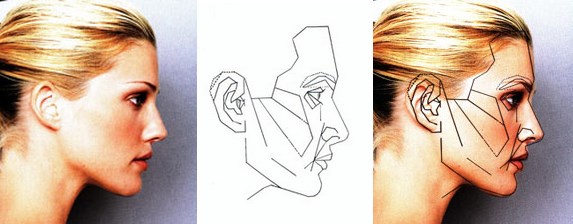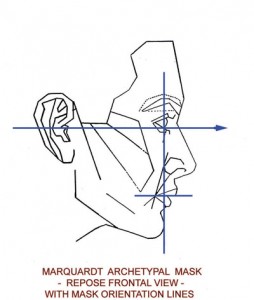
Repose Lateral Mask Application
USES OF THE REPOSE LATERAL MASK:
You can overlay the Repose Lateral Mask (also called the RL Mask or Repose Expression – Lateral View Mask) over a photograph of your own face to help you apply makeup, to aid in evaluating your face for facial surgery (the Repose Lateral View is the view most commonly used by surgeons for pre-surgical evaluation), to aid in the evaluation of your face with regard to orthodontic or dental treatment, or simply to see how much your face conforms to the measurements of the Golden Ratio.
THE REPOSE LATERAL MASK OVERVIEW:
There is more variation between most natural faces and the Repose Lateral Mask than there is between natural faces and the Repose Frontal Mask. This is because we generally perceive (or view) each other (particularly when we interact socially) from the front not from the side. Our evaluation of how human another face appears occurs from the frontal view. Therefore this view is MOST critical for our evaluation of another individual’s humanness. The side configuration (or lateral view) gives the depth to the face and helps give each face its particular individuality. If the face were a song one could think of the front view as the melody and the side view as the harmony or overtones.
Although the Lateral View of the face is not as critical to attractiveness as the frontal view it does add considerably to the overtones of attractiveness. As in the frontal view, the vertical relationships between the facial components can be assessed. However it is only in the lateral view that the front to back relationships between the facial components can also be assessed.
Because there is more variation between most faces and the Repose Lateral Mask than there is between most faces and the Repose Frontal Mask, the application (or fitting) of the Repose Lateral Mask to a photograph of the face is more involved and subject to more variable interpretation.
REPOSE LATERAL MASK APPLICATION PROTOCOL:
(How to apply the Repose Lateral Beauty Mask to your own photo)
1. THIS IS WHAT YOU’LL NEED:
- A camera, and a friend to take your picture
- Access to a copy machine which can re-size pictures
- Sheets of clear acetate (A4 or Letter) to make copies of the mask
- A ruler to measure your face
- A print of the mask: Click here for a copy of the Repose Lateral Beauty Mask for your personal use.
You’ll have to take a picture especially for this experiment, because it’s important to make sure your head is tilted to match the grid of the mask. This is simple to do, but important to get right. Carefully follow the instructions and alignment diagrams, below.
2. TAKING THE PHOTO OF YOUR FACE:
A. PROPER HEAD POSITION / ALIGNMENT FOR TAKING THE REPOSE LATERAL PHOTOGRAPH
The profile position
Face the camera and then turn to your left 90 degrees (1/4 turn), so that the right side of your face (your profile) is facing toward the camera. It is important that the side of your face (your profile) is viewed exactly by the camera. Make sure that only your exact profile is showing and that your head is not turned even slightly toward or away from the camera.
Let the person taking the picture help tell you when you’re in the right position as seen through the camera lens/viewfinder.
The head tilt position
Position your head so that you are facing and looking straight ahead.
A good way to do this is to place a mirror in front of you, and look straight into the mirror moving your head until it appears that your face is neither tilted up nor down.
The position of the eyes
Next, without moving your head, change the direction of the gaze of your eyes from straight ahead and horizontal to straight ahead and gazing slightly upward (about 10 degrees angled upward from the horizontal).
Note: A good way to do this is to hold your right arm straight out in front of you. Keeping your arm straight, bend your wrist so that your fingers are pointing straight up.Now move your arm so that your right thumb nail is covering your right eye in the mirror. Now without moving or tilting your head, raise your eyes from looking at your own eyes in the mirror to looking at the tip of the middle finger of your right hand.
This will be the correct head position and eye position for taking the lateral repose photograph.
With a relaxed face and without smiling, place your back teeth together so that they barely touch and bring your lips together, until they touch gently.
B. CAPTURING THE IMAGE FOR THE PHOTOGRAPH
Now without moving your head, take the picture while your face is in exactly that position.
3. DEVELOPING THE PHOTOGRAPH
The photo size should ideally be as large as 18 X 13cm or 20 X 26cm, (5″ X 7″ or 8″ X 10″). A smaller image will be much less clear and accurate.
4. CREATING THE CORRECT SIZE MASK FOR YOUR PHOTOGRAPH:
On the photo of your face draw the “Mask Orientation Lines”:
First draw a line from the top of your ear hole (called “Porion”) to the lowest part of your lower eyelid (called “Inferior Irion”). Inferior Irion is the point where the bottomor your “Iris” (the colored part of your eye) touches the lower eyelid.
This line is called your “Facial Z-Axis”.
Draw a second line through the corner of your mouth (called “Cheilion”) and parallel to your “Facial Z-Axis” line, extending past the front of your lips. This line is called your “Cheilion Line”.
Draw a third line from “Inferior Irion” at 90 degrees (i.e. perpendicular) to your “Facial Z-Axis” line, and extending superiorly tothe top of your forehead and inferiouly past your “Cheilion Line”. This third line is your “Facial Y-Axis Line”. (see diagram below)

Diagram: The Repose Lateral Mask Orientation Lines
Now, download your copy of the Repose Lateral Mask: Click on the image above to see larger version of the Repose Frontal Mask. Right-Click the image to save it on your computer.
Place the same lines (i.e. the Facial Z-Axis line, the Cheilion Line and the Facial Y-Axis) on your copy of the Repose Lateral Mask as you did on the photo of your face.
Next, take your copy of the Mask and enlarge or shrink it on a copy machine until the “facial vertical distance” (the distance on the “Facial Y-Axis “Line from the “Facial Z-Axis” Line to the Cheilion Line) on the Mask is the same as the distance on your face photo.
Copy the final correctly sized Mask image onto a sheet of clear acetate.
5. APPLYING THE MASK TO THE PHOTOGRAPH:
NOTE: On the Repose Lateral View of the face the most important components of the face to check for fit are those components of the profile. These are primarily the nose, lips, chin and forehead, in that order.
Place the clear acetate mask over your face photo and match up the “Facial Z-Axis” Line, the “Cheilion Line“ and the “Facial Y-Axis” Line of the Mask with the“Facial Z-Axis” Line, the “Cheilion Line“ and the “Facial Y-Axis” Line of the your face photo.
This will establish the “Primary” (or alpha)fit.- Ideal Fit
If you find that the mask profile does not fit your photograph after the initial (or primary/alpha) placement or fitting, then move the mask anteriorly or posteriorly (front of back) sliding the “Facial Z-Axis” Line of the mask along the “Facial Z-Axis” Line of the photograph until the area of the forehead (at the level of the eyebrow) on the mask touches the area of the forehead (at the level of the eyebrow) on the photo.
This will generally improve the overall profile fit.
This will establish the “Secondary” (or beta) fit. – Projection Fit
If necessary you may move the mask up or down, to the right or left, or slightly rotate the mask clockwise or counter-clockwise to increase the degree of overall fit to your face photograph – especially with regard to the fit of your profile to the profile of the mask.
This fitting will establish what is called a “Tertiary” (or gamma) fit. – Rotation Fit
You may also want to make a few copies of the mask, which are progressively slightly larger and slightly smaller than the original acetate. You can use these to see if you can increase the degree of overall fit of your face photograph by slightly adjusting the size of the mask – going through the same procedures as above for each variously sized mask.
When you have found the mask and mask position that most closely fits your face photo, you can take a closer look at your overall fit to the Repose Lateral Mask especially noting your profile fit to the mask.